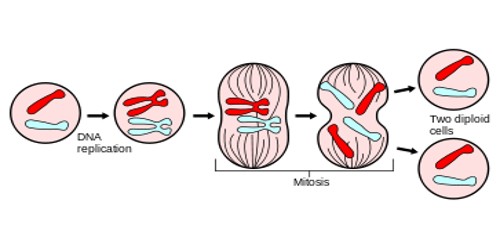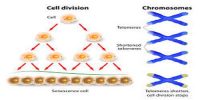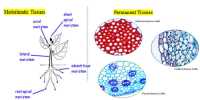Mitosis is a procedure where a single cell divides into two identical daughter cells (cell division). It helps in increasing the number of cells in a living organism thereby playing a significant role in the growth of a living organism.
The significance of mitosis:
(l) To keep the balance between Nucleus and Cytoplasm: The balance between nucleus and cytoplasm is maintained through mitosis so that the shape and size of the cell remain unchanged.
(2) Physical growth: In multi-cellular organisms, a one-celled zygote turns into a many-celled embryo. Repeating the same process the embryo eventually forms the multi-cellular organism. It is responsible for the development of the zygote into an adult.
(3) Formation of reproductive organs: By equational division, reproductive organs are formed in the multi-cellular organism.
(4) Reproduction: In the Eukaryotic organism, reproduction occurs through this process. (Such as in Chlamydomonas)
(5) Keeping the chromosome number constant: Mitosis ensures the quantitative and qualitative distribution of chromosomes in all the cells of an organism. It maintains the constant number of chromosomes in all body cells of an organism.
(6) Repairing of Wounds: Any wounds or broken parts of the organisms can be repaired rapidly by mitosis.
(7) Demerits of mitosis: Turnour, cancer, etc are caused by uncontrolled mitosis.
(8) Keeping the size and shape constantly: By this division the definite shape and size of the cell remains constant.
(9) Healing of injuries: By producing new cells this process repairs the various types of damage of multicellular organisms.
(10) Qualitative stability: Qualitative stability is maintained by mitosis. It is responsible for a definite shape, and proper growth and development of an individual.
(11) Genetic stability: Mitosis helps in the splitting of chromosomes during cell division and generates two new daughter cells. Therefore, the daughter cells formed as genetically uniform and identical to the parent as well as to each other. Thus mitosis helps in preserving and maintaining the genetic stability of a particular population.
(12) Significance for sexual reproduction: Mitosis is significant for sexual reproduction obliquely. It allows the sexually reproducing organism to grow and develop from a single cell into a sexually mature individual. This allows organisms to continue to reproduce through the generations.
(13) Asexual reproduction: Mitosis is used in the production of genetically similar offspring. For example budding of hydra and yeast, binary fission in amoeba, etc.
(14) Replacement and regeneration of new cells- Regeneration and replacement of worn-out and damaged tissues are a very important function of mitosis in living organisms. For example, the mitosis process is used in order to re-growth the legs of newts and crustaceans. However, the degree of re-growth may vary.
Other Significances of Mitosis
- The chromosomes are distributed equally to the daughter cells after each cycle.
- In plants, mitosis helps in the formation of new parts and in the repairing of damaged parts.
- Mitosis helps in vegetative propagation of crops also.
- Since no recombination and segregation occurs in the process, it helps in maintaining the purity of types.
- It helps in maintaining a balance between the DNA and RNA contents of the cell.
- It is responsible for replacing dead and old cells in the animals. Eg., gut epithelium, and blood cells.















